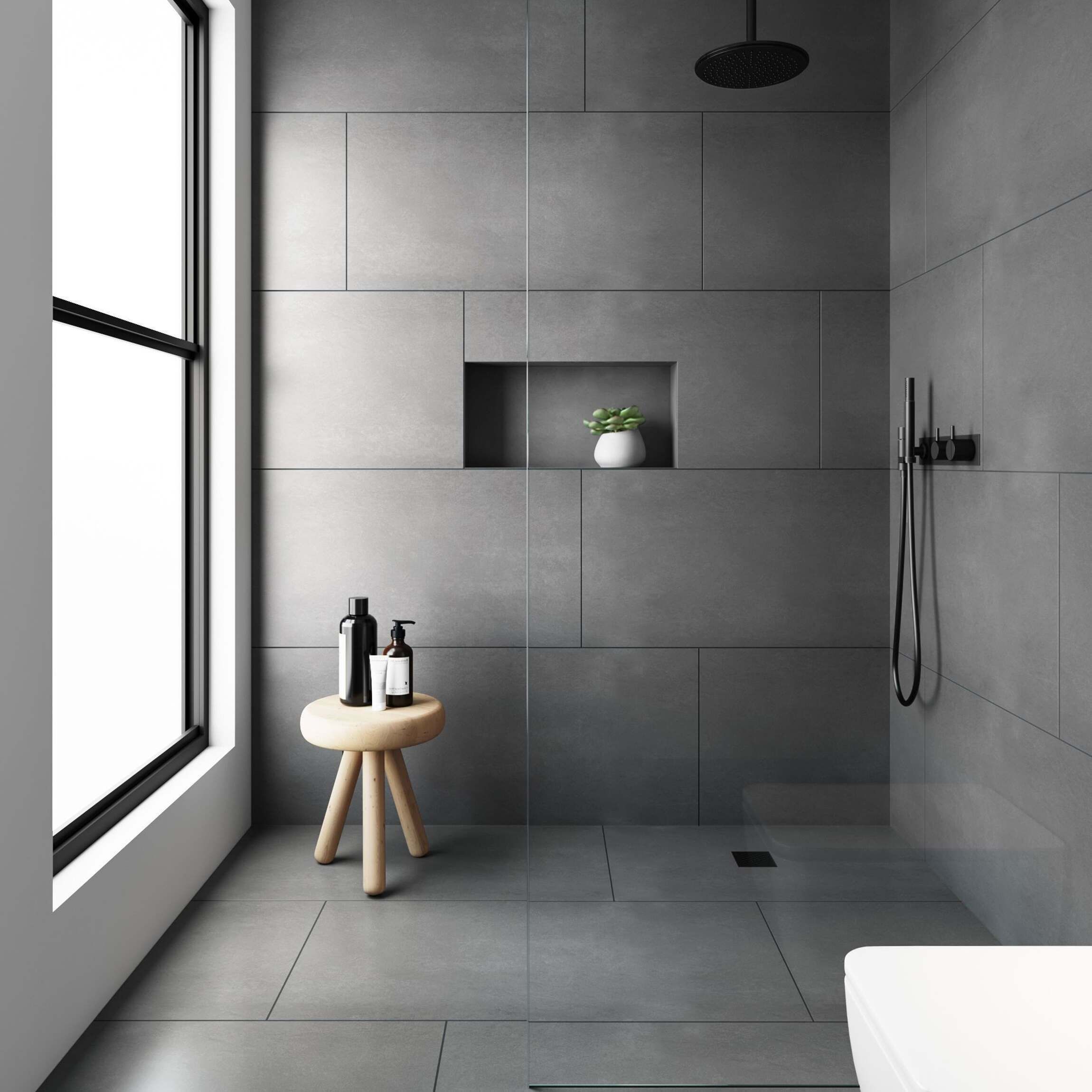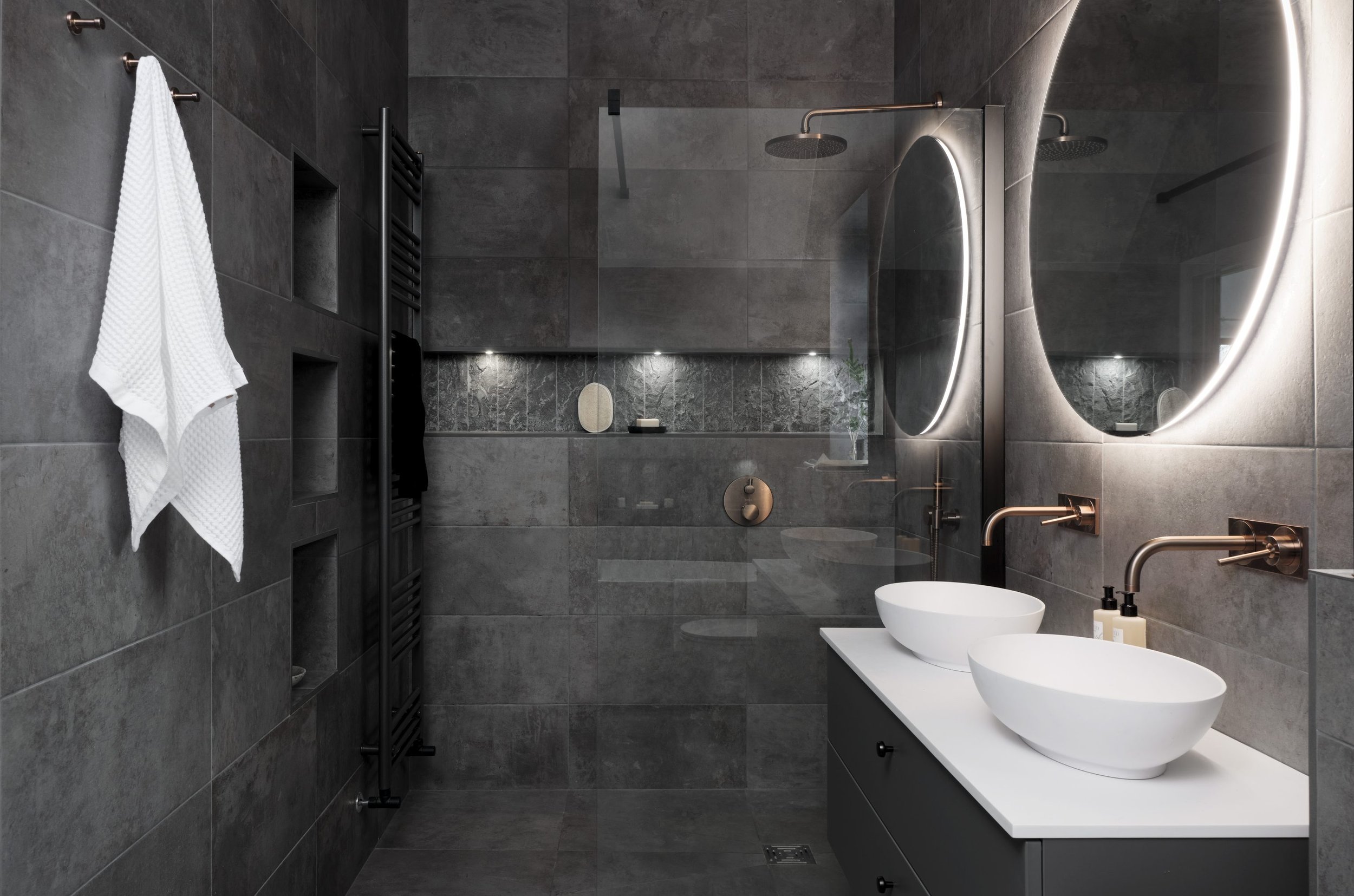Design Inspiration and Trends: Grey And Brown Bathroom

The pairing of grey and brown in bathroom design has become increasingly popular, offering a versatile and sophisticated aesthetic that complements various styles. This color combination creates a sense of warmth and grounding while providing a canvas for diverse design choices.
Grey and Brown Bathroom Color Palettes and Design Aesthetics
The versatility of grey and brown allows for the creation of a wide range of bathroom styles, from modern and minimalist to rustic and industrial.
- Modern Minimalist: Light greys paired with warm browns create a clean and sophisticated aesthetic. This combination is often used in bathrooms with sleek fixtures, minimalist furniture, and geometric patterns. For example, a bathroom with white subway tiles, light grey grout, and a warm brown vanity with brushed nickel hardware would embody this style.
- Rustic: Rich browns and deep greys evoke a sense of warmth and natural beauty, often found in bathrooms with reclaimed wood accents, stone countertops, and vintage fixtures. A bathroom with distressed wood beams, dark grey walls, and a brown stone countertop would create a rustic ambiance.
- Industrial: Dark greys and browns combined with exposed brick, metal accents, and industrial lighting create a raw and edgy aesthetic. For instance, a bathroom with exposed brick walls, a dark grey vanity with black hardware, and industrial pendant lights would reflect this style.
Impact of Grey and Brown Shades on Bathroom Feel
Different shades of grey and brown can significantly impact the overall feel of a bathroom, influencing its warmth, coolness, and spaciousness.
- Light greys create a sense of spaciousness and airiness, while dark greys can make a bathroom feel more intimate and cozy.
- Warm browns, like beige or tan, can add a sense of warmth and comfort, while cool browns, like taupe or charcoal, can create a more sophisticated and elegant feel.
Material Choices and Finishes

Choosing the right materials for your grey and brown bathroom is crucial to achieving the desired aesthetic and ensuring longevity. The combination of these colors offers a wide range of possibilities for textures and finishes, allowing you to create a space that is both stylish and functional.
Tile Choices for Grey and Brown Bathrooms
Tiles are a popular choice for bathroom walls and floors due to their durability, water resistance, and versatility. They come in a variety of materials, colors, and finishes to suit different design preferences.
- Ceramic Tiles: Affordable and durable, ceramic tiles are available in a wide range of colors and finishes, including matte, gloss, and textured. They are a good option for walls and floors, and their water resistance makes them ideal for bathroom use.
- Porcelain Tiles: Known for their high durability and water resistance, porcelain tiles are a good choice for high-traffic areas like bathroom floors. They are also available in a variety of colors, textures, and sizes, including large-format tiles that can create a modern and spacious feel.
- Mosaic Tiles: Small tiles arranged in patterns, mosaics can add a touch of elegance and sophistication to any bathroom. They are available in various materials, including glass, ceramic, and stone, and can be used to create accent walls or intricate designs.
Stone Choices for Grey and Brown Bathrooms
Natural stone offers a unique beauty and timeless appeal, adding a touch of luxury to any bathroom. However, it is important to consider its durability and maintenance requirements before choosing stone for your bathroom.
- Marble: A classic choice for bathrooms, marble is known for its elegant veining and durability. However, it is porous and can be susceptible to staining, requiring regular sealing. Marble is available in a variety of colors, including grey and brown, and can be polished to a high shine or left with a more natural finish.
- Granite: Highly durable and resistant to scratches and stains, granite is a good choice for bathroom floors and countertops. It comes in a variety of colors, including grey and brown, and can be polished to a high shine or left with a honed finish for a more matte look.
- Slate: A natural stone known for its durability and water resistance, slate is often used for bathroom floors and shower walls. It comes in a variety of colors, including grey and brown, and can be left with a natural finish or polished to a smooth surface.
Wood Choices for Grey and Brown Bathrooms
While wood is not typically used for bathroom floors due to its susceptibility to moisture damage, it can be incorporated into the design through vanity tops, cabinets, and accents.
- Teak Wood: Known for its durability and water resistance, teak wood is a good choice for bathroom vanities and cabinets. It has a rich, natural color that complements grey and brown tones and can be left with a natural finish or oiled for a smoother look.
- Walnut Wood: With its distinctive dark brown color and rich grain, walnut wood adds a touch of elegance to bathroom vanities and cabinets. It is relatively durable and can be treated with a sealant to protect it from moisture.
- Bamboo: A sustainable and fast-growing material, bamboo is becoming increasingly popular for bathroom vanities and cabinets. It has a natural, earthy color that complements grey and brown tones and is naturally water-resistant.
Concrete Choices for Grey and Brown Bathrooms
Concrete is a versatile material that can be used for a variety of bathroom applications, including floors, walls, countertops, and sinks.
- Polished Concrete: Polished concrete floors offer a sleek and modern look, and their durability and water resistance make them ideal for bathrooms. They can be stained in a variety of colors, including grey and brown, to create a unique and personalized look.
- Stamped Concrete: Stamped concrete can be used to create a variety of patterns and textures, adding visual interest to bathroom floors and walls. It is available in a range of colors, including grey and brown, and can be sealed to protect it from stains and moisture.
- Concrete Countertops: Concrete countertops offer a unique and industrial look, and their durability and water resistance make them ideal for bathrooms. They can be stained in a variety of colors, including grey and brown, and can be polished to a smooth finish or left with a more natural texture.
Lighting and Decor

Lighting plays a crucial role in setting the mood and enhancing the aesthetics of any bathroom, especially one with a grey and brown color scheme. The right lighting can highlight the beauty of the space, create a sense of warmth and comfort, and even make the room appear larger.
Types of Lighting Fixtures
Proper lighting is essential for creating a welcoming and functional bathroom. Here are different types of lighting fixtures that can enhance the grey and brown color scheme:
- Ambient Lighting: This is the overall lighting that illuminates the entire bathroom. It can be achieved using recessed ceiling lights, pendant lights, or track lighting. For a grey and brown bathroom, warm white or soft white LED bulbs are recommended to create a cozy and inviting ambiance.
- Task Lighting: This type of lighting is focused on specific areas, such as the vanity mirror or shower area. Sconces, vanity lights, or under-cabinet lighting are excellent choices for task lighting. Consider using LED bulbs with a higher color temperature for better visibility while applying makeup or shaving.
- Accent Lighting: Accent lighting is used to highlight specific features or decorative elements in the bathroom. This can be achieved using wall sconces, picture lights, or strip lights. Use accent lighting to highlight a unique piece of artwork or a beautiful plant. Consider warm white or soft white LED bulbs to complement the grey and brown color scheme.
Decorative Elements
Decorative elements can add personality and visual interest to a grey and brown bathroom. Here are some suggestions for incorporating decor:
- Plants: Plants bring life and freshness to any space, and they can be particularly effective in a grey and brown bathroom. Consider adding a small potted plant to a shelf or countertop, or a larger plant in a corner. Plants that thrive in humid environments, such as ferns, orchids, or snake plants, are good choices for a bathroom.
- Artwork: Artwork can add a pop of color and personality to a grey and brown bathroom. Choose pieces that complement the color scheme and reflect your personal style. Abstract art, nature-inspired prints, or black and white photography can work well in a grey and brown bathroom.
- Accessories: Accessories can add the finishing touches to a grey and brown bathroom. Consider using towels, rugs, and shower curtains in complementary colors, such as beige, ivory, or teal. Adding decorative storage baskets, soap dishes, or toothbrush holders can also enhance the look and functionality of the space.
Accent Colors and Patterns
Accent colors and patterns can add visual interest and break up the monotony of a grey and brown bathroom. Here are some tips for selecting complementary colors and patterns:
- Complementary Colors: Complementary colors are located opposite each other on the color wheel. They create a strong contrast and can add a bold statement to a grey and brown bathroom. Consider using complementary colors such as teal and brown, or pink and grey.
- Analogous Colors: Analogous colors are located next to each other on the color wheel. They create a harmonious and balanced look. Consider using analogous colors such as grey, brown, and beige.
- Patterns: Patterns can add visual interest and texture to a grey and brown bathroom. Consider using geometric patterns, floral prints, or stripes in complementary colors.
